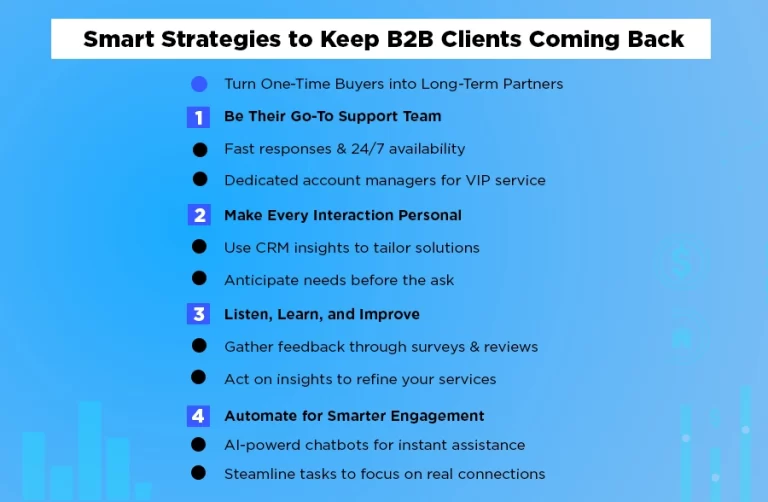Schedule a FREE call with our outsourcing expert now and get a precise quotation that meets your requirements. Don't wait - get started today!
Businesses don’t thrive on products alone. In the B2B space, quality services determine whether a company grows, retains clients, or fades into obscurity. When SMEs deliver exceptional service, they build long-term partnerships, strengthen brand reputation, and create a foundation for sustainable success.
Think about it—why do companies stay loyal to a service provider? It’s not just about the lowest price or fastest delivery. It’s about trust, reliability, and a seamless experience that keeps operations running smoothly. Quality services ensure that clients get more than just what they paid for; they get confidence in your business.
For SMEs competing in the B2B market, prioritizing service quality isn’t optional—it’s a necessity. Let’s explore how high-quality services can fuel growth and secure long-term client retention.
What Defines Quality Services in B2B?
Quality services go beyond meeting basic expectations. They involve understanding client needs, providing consistent value, and building trust. For SMEs, this means tailoring offerings to address specific challenges faced by business clients and ensuring that each interaction leaves a positive impression.
1. Understanding Client Needs
SMEs must actively listen to their clients. Learning their pain points and objectives allows businesses to customize their services effectively. This involves conducting regular check-ins, surveys, and open discussions to align offerings with evolving client demands.
2. Delivering Consistent Value
Clients expect reliability. A consistent experience builds trust and ensures repeat business. Maintaining service quality requires clear processes, well-trained staff, and efficient quality control measures to guarantee that every client receives the same level of service.
3. Enhancing Customer Experience
Providing seamless interactions across multiple touchpoints helps businesses retain clients and improve satisfaction. From user-friendly digital platforms to responsive customer support, every aspect of service delivery should be designed to make clients’ lives easier.
4. Building Long-Term Trust
Trust is the foundation of strong B2B relationships. Honesty, transparency, and dependability strengthen business ties. Clear contracts, realistic promises, and consistent follow-through on commitments demonstrate a company’s dedication to its clients.
How Quality Services Improve Client Retention
Retaining clients is more cost-effective than acquiring new ones. Quality services play a significant role in this. When clients receive exceptional service, they are more likely to remain loyal. In fact, B2B companies that successfully engage their customers experience 63% lower customer attrition. This means that businesses investing in quality services not only maintain their existing customer base but also reduce churn, securing steady revenue streams.
1. Stronger Business Relationships
Loyal clients contribute to steady revenue. Quality services ensure they continue their partnership with your business. By consistently delivering value, SMEs can transform one-time buyers into long-term partners who trust their expertise and reliability.
2. Higher Client Satisfaction
Satisfied clients are less likely to explore competitors. Consistently meeting their expectations secures long-term loyalty. When businesses actively address concerns, improve services based on feedback, and exceed expectations, they create a positive cycle of satisfaction and trust.
3. Increased Referrals and Word-of-Mouth
Happy clients become brand advocates. Their recommendations bring in new business without additional marketing costs. A satisfied client is more likely to refer a business to others, amplifying growth opportunities through organic marketing efforts.
4. Competitive Advantage
In a crowded market, quality services differentiate your SME. Companies that focus on excellence naturally stand out. Businesses that consistently provide outstanding service establish a strong reputation, making them the preferred choice among competitors.
Strategies to Implement Quality Services for B2B Success
For SMEs aiming to enhance their B2B growth and client retention, focusing on quality services is essential. Here are some strategies:
1. Personalized Client Interactions
Understanding each client’s unique needs and preferences allows SMEs to offer tailored solutions. Personalization shows clients they are valued, fostering stronger relationships. Small gestures like remembering previous discussions, customizing solutions, and addressing specific business challenges make a significant impact.
2. Consistent Communication
Regular and clear communication builds trust. Keeping clients informed about developments, changes, or issues demonstrates transparency and commitment. Providing timely updates and being responsive to inquiries reassures clients that they are a priority.
3. Proactive Support
Anticipating client needs and addressing potential problems before they escalate showcases dedication to service excellence. Proactive support can differentiate an SME from competitors. This involves offering solutions before a problem arises, conducting regular service audits, and maintaining open communication.
4. Soliciting and Acting on Feedback
Actively seeking client feedback and implementing changes based on their suggestions indicates that an SME values continuous improvement and client input. A structured approach to gathering and applying feedback enhances service offerings and ensures businesses evolve with client needs.
5. Investing in Employee Training
Ensuring employees are well-trained and knowledgeable enables them to deliver quality services effectively. Continuous training keeps staff updated on best practices and industry standards. Well-equipped employees are better positioned to handle client concerns, troubleshoot issues, and maintain service excellence.

How to Build a Feedback Loop That Improves Service Delivery
A feedback loop is a powerful tool that helps businesses continually improve by gathering insights directly from clients. It leads to better service delivery and stronger client relationships when done correctly. Here’s how to implement it effectively:
1. Establish Clear Channels for Feedback
Create multiple, easy-to-use channels for clients to share their feedback. This could include surveys, email, live chat, social media, or even direct calls. The key is ensuring clients feel comfortable and empowered to share their thoughts.
2. Actively Listen to Client Feedback
It’s essential to not only collect feedback but also listen to it. Whether the feedback is positive or negative, each piece of information is valuable. Assign a team member or department to monitor these channels regularly to ensure you get a comprehensive view of your client’s experiences.
3. Analyze and Identify Trends
Once you’ve gathered enough feedback, analyze it to identify recurring issues, patterns, and trends. Are there specific service areas that need attention? Are certain touchpoints consistently mentioned by clients? This analysis helps prioritize where changes are needed the most.
4. Close the Feedback Loop
Clients appreciate knowing that their feedback matters. Communicate back to them about the actions you’ve taken based on their input. Whether it’s a service improvement or a new feature, keeping them in the loop demonstrates that their opinions are valued.
5. Continuously Monitor and Refine
Feedback should not be a one-off event. Build a system that allows for continuous feedback collection and improvements. Track how changes affect client satisfaction over time, and keep refining the process to ensure service delivery keeps improving.
Implementing a Proactive Support System to Prevent Client Issues
Proactive support is about anticipating client needs and resolving potential issues before they become problems. This approach builds stronger relationships, reduces churn, and enhances the overall client experience. Here’s how to implement it:
1. Identify Common Client Pain Points
Start by understanding the common challenges your clients face. This can be done through past client interactions, support tickets, or surveys. By identifying the areas where clients commonly struggle, you can anticipate where proactive support is most needed.
2. Provide Self-Service Resources
Develop and offer a comprehensive knowledge base or help center where clients can find answers to frequently asked questions or troubleshoot issues on their own. This not only reduces the need for clients to reach out for support but also empowers them to resolve their issues quickly.
3. Set Up Regular Check-Ins
Rather than waiting for clients to reach out when problems arise, set up regular check-ins to gauge their satisfaction and offer help. These check-ins can be via phone calls, emails, or virtual meetings, providing an opportunity to catch potential issues early.
4. Use Predictive Analytics to Anticipate Needs
Leverage technology and predictive analytics to analyze patterns in client data. By recognizing trends, you can predict potential issues before they occur. For example, if data shows that clients tend to experience difficulties at a certain stage of the service, you can address these issues proactively.
5. Establish a Dedicated Support Team for Proactive Actions
Create a dedicated team or department focused on proactive support. This team can monitor client accounts, identify risks, and suggest solutions before clients experience problems. Their role is to prevent problems rather than just solve them when they arise.
6. Train Staff to Be Proactive Problem-Solvers
Ensure that your customer service team is trained to anticipate issues and provide solutions before clients even ask. Empower them to suggest improvements or changes that could enhance the client experience. This could involve providing them with the knowledge and tools to act quickly when a potential issue arises.
Measuring the Impact of Quality Services
To understand the effectiveness of quality services, SMEs should track key performance indicators (KPIs) such as client satisfaction scores, retention rates, and referral rates. Analyzing these metrics helps refine strategies and demonstrates the value of quality services. Using data-driven insights allows businesses to identify strengths and areas that need improvement, ensuring consistent service quality.
1. Client Satisfaction Scores
Tracking surveys and feedback forms help measure how well services meet client expectations. High satisfaction scores indicate a positive client experience, while lower scores highlight areas requiring improvement.
2. Client Retention Rate
A high retention rate indicates strong service quality and client satisfaction. Monitoring client retention over time helps businesses gauge the long-term impact of their service quality initiatives.
3. Referral Metrics
The number of new clients referred by existing customers is a good indicator of service excellence. An increase in referrals signifies that current clients trust and appreciate the service enough to recommend it to others.
4. Service Improvement Analysis
Identifying areas for improvement based on performance data ensures ongoing growth and competitiveness. Businesses that actively refine their services based on analytical insights maintain a leading edge in the industry.
Strengthen Client Bonds with Quality Services
Book your FREE 60-minute business consultation today, and let’s strategize how to elevate your operations—NO COMMITMENTS, just results-driven insights!
Magellan Solutions offers a range of services tailored for SMEs, including outbound telemarketing services Philippines, customer support outsourcing, virtual receptionist services, and back-office solutions. We focus on delivering quality services that help businesses build lasting client relationships, improve retention, and establish a strong market presence. Let us help you create a service experience that keeps clients coming back.














